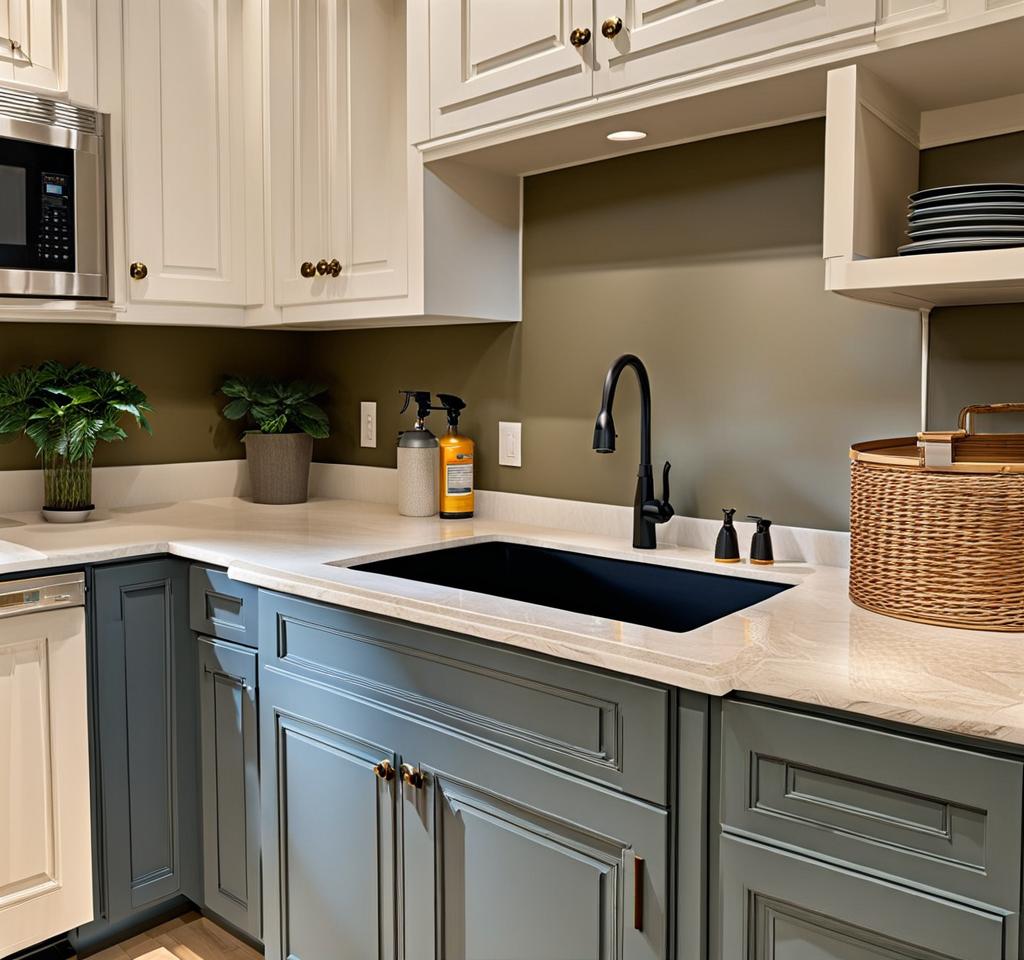Painting cabinets typically involves an arduous process of sanding to ensure proper adhesion. However, innovative techniques and specialized paints now allow you to achieve flawless results sans the grueling sanding step. Imagine reviving your kitchen’s aesthetic without enduring the dust-filled ordeal of sanding every nook and cranny.
By leveraging cutting-edge methods and materials, you can expedite the process while maintaining impeccable finishes. Get ready to unlock a world of effortless cabinet transformations!
Preparing Cabinets for Painting Without Sanding
While sanding serves to create an ideal surface for paint adhesion, skipping this step requires meticulous preparation. Begin by thoroughly cleaning the cabinets, removing any grease, grime, or residue that could impede paint adhesion. A degreasing solution or a mixture of warm water and TSP (trisodium phosphate) effectively cuts through stubborn buildup.
Next, lightly scuff the existing finish using a non-abrasive scrubbing pad or a liquid deglosser. This process slightly roughens the surface, allowing the new paint to grip securely without the need for vigorous sanding. Ensure thorough coverage, paying close attention to corners and crevices.

Once the surface is prepped, wipe away any residual dust or debris with a clean, lint-free cloth. This crucial step ensures a pristine canvas for your paint application, minimizing the risk of imperfections or adhesion issues.
Specialized Cabinet Paints Eliminating Sanding Need
The secret to bypassing the sanding step lies in the advanced formulation of specialized cabinet paints. These innovative products are designed with superior adhesion properties, allowing them to bond directly to glossy or previously painted surfaces without extensive surface preparation.
Chalk-based paints have gained immense popularity for their incredible adherence and velvety-smooth finish. Their unique chalky texture clings tenaciously to existing finishes, making them an ideal choice for painting cabinets without sanding. Additionally, these paints often boast a built-in primer, further streamlining the process.
Acrylic-based cabinet paints with explicit “no sanding” claims also offer a remarkable solution. Their proprietary formulations create a lasting bond with glossy surfaces, ensuring a flawless, long-lasting finish without the hassle of sanding.
Crucial Considerations
When selecting a specialized cabinet paint, carefully review the manufacturer’s instructions and recommendations. Some paints may require a specific primer or bonding agent to achieve optimal adhesion without sanding. Additionally, consider factors such as durability, ease of application, and desired sheen level to find the perfect match for your project.
Time-Saving Techniques for No-Sand Cabinet Transformation
Beyond the specialized paints, several clever techniques can expedite the cabinet painting process while eliminating the need for sanding. One ingenious method involves using liquid sandpaper or deglosser products. These potent solutions chemically etch the existing finish, creating a rough surface for the new paint to adhere to without manual sanding.
Another time-saving approach is the application of a high-adhesion primer specifically formulated for glossy surfaces. These primers create an intermediate layer that bonds seamlessly to the existing finish while providing an ideal surface for the topcoat paint to grip onto.
For intricate cabinet details or hard-to-reach areas, consider using a cabinet-specific spray paint designed for adhesion without sanding. These aerosol products offer precise application and excellent coverage, ensuring a professional-grade finish in even the trickiest spots.
Best Tools and Materials for Seamless Cabinet Painting
To achieve optimal results when painting cabinets without sanding, having the right tools and materials is paramount. Invest in high-quality brushes and rollers designed for smooth, even paint application. Opt for dense foam rollers or high-density microfiber rollers, which minimize the appearance of brush strokes and ensure a uniform finish.
Additionally, consider using a paint sprayer for larger cabinet surfaces or intricate details. A high-volume, low-pressure (HVLP) sprayer delivers a consistent, even coat of paint without the need for excessive brushwork, saving time and effort.
Don’t forget to equip yourself with essential supplies such as drop cloths, painter’s tape, and plastic sheeting to protect surrounding areas from overspray or drips. Proper preparation and organization will streamline the painting process, ensuring a stress-free and efficient transformation.
Step-by-Step Guide to Paint Cabinets Without Sanding
With the right materials and techniques at your disposal, you’re ready to embark on the cabinet painting journey. Follow this step-by-step guide for a flawless, no-sanding cabinet transformation:
- Thoroughly clean and degrease the cabinet surfaces, removing any residue or buildup.
- Lightly scuff the existing finish using a non-abrasive scrubbing pad or liquid deglosser.
- Wipe away any dust or debris with a clean, lint-free cloth.
- Apply a high-adhesion primer or bonding agent, if recommended by the paint manufacturer.
- Apply the first coat of specialized cabinet paint, allowing for proper drying time between coats.
- Sand lightly between coats (if needed) using a fine-grit sandpaper to ensure a smooth finish.
- Apply the final coat of paint, ensuring even coverage and a flawless finish.
- Reinstall hardware, doors, and drawers once the paint has fully cured.
Remember, patience and attention to detail are key throughout the process. Take your time, follow manufacturer instructions, and prioritize proper surface preparation for optimal results.
Once your cabinet transformation is complete, the real magic lies in preserving that pristine, freshly painted look for years to come. Regular cleaning and maintenance are crucial to ensure the longevity of your no-sanding paint job.
Avoid harsh chemicals or abrasive cleaners that could potentially damage the paint finish. Instead, opt for gentle, pH-neutral cleaners formulated specifically for painted surfaces. A mild soap and water solution can effectively remove light dirt and grime without compromising the paint’s integrity.
Additionally, consider applying a clear, protective topcoat to enhance the durability and resistance of your painted cabinets. These topcoats act as a barrier against moisture, stains, and scratches, prolonging the vibrant appearance of your cabinets for years to come.
With the right care and maintenance routine, your beautifully painted cabinets will remain a stunning focal point in your space, serving as a testament to the power of innovation and the art of effortless transformations.

This is where you’ll find inspiration to create a stylish and beautiful dream home.